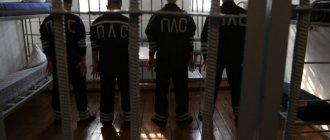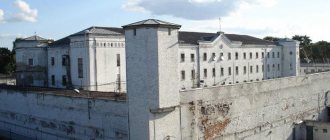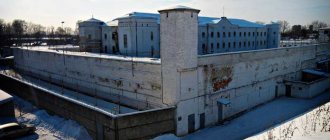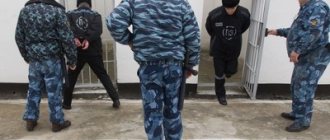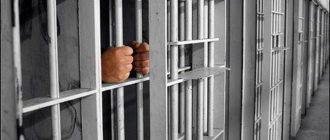Prison jargon differs significantly from the spoken Russian language to which each of us is accustomed. The meanings of many words are rethought here, and familiar terms are simply replaced. And one of the words unknown to the common man is “lid”. This is the name of a maximum security prison. Prisoners caught in “krytki” are called “krytniks”.
How a covered prison differs from a regular one, and why prisoners are afraid to end up in a “cover” - more on that below.
White Swan
This penal colony houses prisoners sentenced to life imprisonment. This Russian prison is located in the city of Solikamsk, Perm Territory, at st. Karnalitovaya, 98. Administration telephone numbers: 8 (34253) 72136, 8 (34253) 72193.
“White Swan” traces its history back to 1938, when the commandant route of the Usolsky correctional camp was created in its place. During Soviet times, many political prisoners passed through it, but criminal authorities were also kept in this prison.
Why is it considered one of the most terrible?
This is one of the most terrible prisons in Russia with strict internal regulations. As soon as the observation window opens in the cell, all prisoners must stand facing the wall, with their feet shoulder-width apart and their hands raised. They stand like that while the warden inspects the cell.
There are three people per cell. They are selected by comparing psychological types and selecting compatible ones, which is not easy, given the contingent of the colony.
Once a day, an hour-long walk outside is allowed and a shower once a week. But these convicts have the right to correspondence only after 10 years of their sentence.
Who gets here?
Since 1999, the White Swan prison has become a special colony for holding terrorists, serial killers, maniacs, and leaders of criminal groups. All prisoners of this penal colony have life sentences.
Among the most famous prisoners of the White Swan:
- Terrorists Yusuf Kryshakhmalov and Salman Raduev.
- Rapist Dmitry Karimov.
- Killer Dmitry Vinogradov.
- Lom-Ali Gaitukaev, recognized as the organizer of the murder of journalist Anna Politkovskaya.
In addition to them, lesser-known but no less dangerous criminals are serving their sentences in this prison.
Contents of convicts
There are basic internal rules in prisons of this level, however, some colonies may have their own minor changes. The rules are:
- Movement around the territory is only possible with an escort and service dogs.
- To move around, prisoners wear a blindfold or go without a blindfold, but their hands are always handcuffed behind their backs.
- Two criminals live in the cells; especially dangerous ones can be placed in solitary confinement.
- Distribution among cells occurs in accordance with the psychological type of criminals.
- Prison inmates are monitored 24 hours a day, both on site and in their cells.
Despite strict detention measures, restrictions on walks and personal communication with relatives, certain types of activities are available to criminals.
For example, they can use the library, work part-time, or buy personal items in the prison store.
Conditions of detention for prisoners include:
- early rise - at 6 o'clock in the morning;
- late sleep - after 23 hours;
- taking a shower once a week;
- walks no more than 1.5 hours a day under escort;
- Three meals a day;
- regular examination by medical professionals;
- educational sessions with a social worker.
Butyrka
Moscow pre-trial detention center (Novoslobodskaya str., 45, 8 (499) 7912132, 8 (499) 9787546) is one of the oldest prisons in Russia among those currently existing. It was created by order of Catherine II in 1771. The prison building was designed by architect Mikhail Kozakov. On the territory of the detention center there is the Church of the Intercession, built by him.
Since the 19th century, Butyrka was the main transit prison for convicts heading to Siberia. During Soviet times, thousands of repressed people passed through it. Often a cell held up to 170 prisoners. The total number of prisoners reached 20 thousand people.
Why is it considered one of the most terrible?
The conditions of Butyrka at the beginning of the last century led prisoners to mass suicide. The guards used various methods of abuse and torture. In particular, prisoners were required to scrub the floors in their cells so that when checked with a handkerchief, it would remain clean. If there was dirt left somewhere, the cell was sent to a punishment cell. And in the punishment cells located in the basement of the detention center, various torture instruments were equipped.
Until 1994, people sentenced to death were executed in this Moscow prison. The number of those executed over all the years of Soviet power is enormous, especially many people, including innocent ones, died here during the period of Stalin’s Great Terror.
Today, the conditions of this terrible Russian prison, of course, are not so harsh, but they are also far from normal. The cells contain 20-25 people. Since smoking is allowed in the cells, it is difficult to breathe there. Outdoor walks in Butyrka are irregular. Overcrowding in cells leads to prisoners sleeping in shifts.
Who gets here?
The detention center includes 10 buildings, each of which is intended for a specific category of prisoners:
- Persons under investigation.
- Juvenile delinquents.
- Women.
- Waiting stage.
- Repeat offenders.
Among the prisoners during the long history of this prison were legendary historical figures: Emelyan Pugachev, Felix Derzhinsky, Kliment Voroshilov, Nikolai Bauman, writer Alexander Solzhenitsyn and poet Osip Mandelstam.
Some statistics
How many people are in Russian prisons?
The activities of correctional institutions are regulated by the Criminal Procedure Code of the Russian Federation. The penal system has undergone significant changes over the past decade.
Some zones were repurposed into settlement colonies, and the number of correctional colonies for minors was significantly reduced. There is a gradual shift away from keeping people in prison for minor crimes.
This has led to the fact that the number of prisoners in the Russian Federation has decreased to 630 thousand people by 2022. This also includes people in pre-trial detention centers.
For comparison, in 2000, about 1 million people were serving time in Russian prisons. Only the USA has more prisoners than in the Russian Federation.
Over 10 years, the number of crimes in Russia has decreased by almost 40%. However, the number of people behind bars decreased by only 19%.
According to statistics, the number of sentences for murder and drug-related crimes has increased in the country. At the same time, there have been fewer convictions for theft, robbery, and causing harm to health.
There are fewer and fewer prisoners in Russian prisons and zones! TVNZ:
https://youtube.com/watch?v=kHzpNrDVIg8%3Fecver%3D1
Why do they give life imprisonment in our country? Read about it here.
Vladimir Central
Prisoners who have committed particularly serious crimes or have maliciously violated the regime in other colonies are placed in this prison in the city of Vladimir (Bolshaya Nizhegorodskaya St., 67, 8 (4922) 324068, 8 (4922) 325316).
This strict Russian prison was created in 1783 for political prisoners. Later, criminals were also sent there.
The prison became central in 1906 and had this status until the 70s of the 20th century. In the 90s, convicts considered it prestigious to get into it. As in other similar places of detention, the cells in the Vladimir Central were constantly overcrowded.
Why is it considered one of the most terrible?
“Vladimir Central” is famous for the fact that not a single prisoner could escape from this terrible prison in Russia. Prisoners with long sentences (from 25 years) are kept in detachments. Gradually, the prison is being renovated and cells with TVs and refrigerators are appearing. But only those who comply with prison discipline end up in such cells.
With all these changes, there are still rumors about the Vladimir Central as a very cruel prison, in which many events are hidden by the administration.
In 2022, prisoner Andrei Grachev died in prison. There were numerous signs of violence on his body. Shortly before his death, he warned that reprisals were being prepared against him by the prison administration.
Who gets here?
Convicts of this terrible Russian prison committed murders, terrorist attacks, or maliciously violated the regime of detention in other penal colonies. But in Soviet times and before the revolution they went through it:
- Revolutionary Mikhail Frunze.
- Vasily Stalin, convicted after the death of his father.
- Singer Lidiya Ruslanova.
- Actress Zoya Fedorova.
- Philosopher Kim Fadeev.
Today, Vladimir Central still remains one of the harshest prisons in Russia.
Mordovian prison
IK-14, located in Mordovia, is a women's prison. It rightfully made it to the top of the most terrible colonies in Russia, because in addition to the severity of the stay, the rights of prisoners are violated there. There are no women’s prisons for life imprisonment in the country, but this colony will give Vladimir Central a head start. In 2013, Nadezhda Tolokonnikova, a convicted member of the Pussy Riot group, spoke about the lawlessness that occurs behind the walls of the institution. Her words were not taken seriously until it became known in 2018 that prisoners were being forced to work overtime at night. The criminals in this colony are slaves.
Women who have committed murders or other serious crimes are imprisoned in the Mordovian prison. There is not enough space in the cells, so prisoners sleep on the floor or under their beds. Medical care for these people is not provided in the proper form; every second person suffers from syphilis or tuberculosis. One cell can accommodate 40-60 people. Women behave more aggressively than men, so fights are not uncommon.
Food in the colony is meager, although it is considered balanced. The products purchased are cheap and of low quality, which also affects the health of the prisoners. If a woman has wealthy relatives who bring her food, she cooks separately and eats herself. But according to the unwritten rules of prisoners, the “elder” can take it away.
Vologda nickel
This prison for life prisoners is located on Ognenny Island, Belozersky District, Vologda Region. The administration can be contacted by phone: 8 (81756) 45135, 8 (81756) 38507.
This unusual location of the prison is due to the fact that it is located in the building of a former monastery. One and a half meter walls that come straight out of the water eliminate the possibility of escape.
During the Stalinist repressions, political prisoners were kept in the Vologda Pyatak; later the prison became a place for imprisonment of criminals.
Why is it considered one of the most terrible?
Given the special population of the prison, prisoners are kept in groups of two in closed cells, and some of the unbalanced and especially dangerous ones are kept in solitary confinement.
Prisoners are allowed to walk (an hour a day) and read books. But from 6 am to 10 pm you are not allowed to lie or sit on the bed in the cells. Watching TV and meeting with family is allowed only to those who have served at least 10 years of their sentence.
Who gets here?
Many of the current prisoners of the Vologda Pyatak committed murders in the 90s. These are both members of criminal gangs and terrorists, as well as “domestic workers” who killed while intoxicated.
Among the prisoners whose cases made a splash in the press:
- Terrorist Arasul Khubiev, who organized the explosion in Mineralnye Vody in 2001.
- Yusup Yunusov, gang member responsible for 70 deaths.
- Serial killer Vasily Shivkoplyas, who killed 15 people.
- Artyom Anufriev, responsible for the death of 6 people.
The strict conditions of detention in the Vologda Pyatak correspond to the danger of the prisoners held there.
Eletskaya cover
The prison is located in the city of Yelets, Lipetsk region (Proletarskaya St., 1B, tel.: 8 (47467) 71847.
The buildings on the territory of the present Yeletskaya krytka were used as a prison back in the 16th century. Then they were simply holes dug in the ground, covered with boards on top. A stone building with prison cells appeared here in 1830.
Why is it considered one of the most terrible?
In the old days there were unbearable conditions here. Prisoners were chained to the wall for any offense and kept in cells without light or food. There was a high mortality rate in prison. Also, quite a few prisoners went crazy.
Today, Yeletskaya Krytka remains one of the most terrible prisons in Russia. All newcomers are placed in cells with “experienced” prisoners, whose goal is to intimidate the new arrivals.
There are many rumors about facts of violence against prisoners in this prison, including from the administration.
Who gets here?
About 80% of prisoners in this penal colony are serving time for murder.
Among the famous prisoners:
- Thief in law Vitalik Tbilissky.
- Tariel Oniani, also a thief in law and leader of the Kutaisi organized crime group.
- Thief in law from Chechnya Akhmed Shalinsky.
The list of such people in Yelets prison can be continued for a long time.
We're sitting well
However, the places where the former oligarch will serve his sentence are not so unknown as they are not so remote. At least all the addresses are now known and the routes have long been trodden.
“If anything, I wish you a camera on the sunny side” - this phrase has long become folklore among our compatriots, and especially among large businessmen. "Rossiyskaya Gazeta" decided to find out the exact coordinates of the sunniest cameras in the country, but who knows when, God forbid, it will come in handy. But knowledgeable people explained that it is better to choose a camera on the shady side: it is not so hot. However, for Khodorkovsky this is no longer relevant; he needs to prepare for a housewarming in a general regime colony. There, rather, we should talk about a bed in a sunny corner.
Conditions in the colonies can be compared to those in the army: large, bright rooms reminiscent of barracks, a strict daily routine, high fences around the perimeter. So where is a good place to sit in Russia? Nowhere, because bondage is always bondage. But there are colonies where living conditions are better, and others where they are worse. And there are legendary camps and prisons on which memorial plaques are just right. Their walls and corridors are steeped in history.
Prisons as such appeared in Russia in the middle of the 16th century. Before this, criminals were immediately killed, but for minor offenses they were beaten or fined. Then the forts appeared. And then the authorities decided that there was no need for the robbers to sit, let them work - and so penal servitude arose. In those days, punishment for an indefinite period, until special order from the king, was very popular. Sometimes it came, and sometimes it didn’t, and the person died in prison. In 1937, the authorities creatively reworked this measure. The famous “ten years without the right to correspondence” appeared, which essentially meant execution. The rest of the convicts disappeared into the vast expanses of the Main Directorate of the NKVD camps. Even the names of its departments speak about the scope of the great archipelago: highways, hydraulic engineering, airfield construction, forestry and fuel industries. The Gulag had everything to do with it, and everything came to the hands of slaves. After all, in those years they planted a lot in the country and with pleasure.
Then other times came and came. The prison department changed along with them. It was leaked, bottled, reformed... It ended with the fact that on July 28, 1998, the President of Russia transferred the Main Directorate for the Execution of Punishments from the Ministry of Internal Affairs to the Ministry of Justice. And on March 9, 2004, the GUIN of the Ministry of Justice was transformed into the Federal Penitentiary Service. Her address: Moscow, Zhitnaya street, 14. Remember it just in case.
Closed capital
Moscow has the highest density of known prisons per square meter. The competition among pre-trial detention centers is such that you still have to fight for the right to become legendary. The undisputed leaders: “Matrosskaya Silence” and “Butyrka”. It’s not for nothing that they have corresponding numbers: pre-trial detention center No. 1 and pre-trial detention center No. 2.
“Butyrka” is listed second, although, honestly, it should be considered first. Emelyan Pugachev was still sitting in it. And in 1908, the poet Vladimir Mayakovsky sketched out his first poems. Felix Dzerzhinsky also attended prison universities here before the revolution.
“Matrosskaya Tishina” earned a big name already in the Soviet years. And the detention center got its name thanks to the street on which it is located. Before the opening of the prison, this part of Moscow was famous for the sailing fabric factory founded by Peter I. Right next door, there was also an almshouse for elderly and crippled sailors. Hence the symbolic “silence”, which so successfully formed the name of a non-sea establishment.
Today “Matrosskaya Tishina” is two in one. One is a regular detention center, the other is a special one, for special prisoners. Mikhail Khodorkovsky, by the way, visited both detention centers. In addition, film producer Mark Rudinshtein whiled away his days within the walls of “Matrosskaya Tishina”: in the late 1980s. Businessman Sergei Mavrodi has been in this detention center for so long that he has already become something of a local ghost. Here, the “star” of Soviet cinema, Georgy Yumatov, the widow of a general, Tamara Rokhlina, accused of murdering her husband, and the former head of the financial service of the Russian Ministry of Defense, Colonel General Georgy Oleynik, got a taste of bondage. And many, and many others...
House for spies
Lefortovo is the most mysterious pre-trial detention center. For now he is under the wing of the FSB. But in the near future he will transfer to the Federal Penitentiary Service. The isolation ward is small, with about a hundred seats. Living conditions are beyond praise. The regime is better not to remember, it is observed very strictly. The audience here is selective. And on both sides. Candidates for service undergo a special check. And the inmates are on business of special national importance. The FSB doesn’t deal with anything else.
In the shadow of celebrities
The rest of the capital's pre-trial detention centers are in the shadow of their celebrities. “Krasnopresnenskaya forwarding” holds a confident third place in the unofficial standings. It was built under Stalin, in 1937. In those years, you understand, there was a special need for such institutions.
Prisoners from all pre-trial detention centers were brought here - those whose sentences had already entered into legal force. From here the prisoners went to camps. This order lasted for a long time. But now pre-trial detention center No. 3 “Presnya” (the same transfer) also works as a regular pre-trial detention center. Some of the cameras here have been renovated and now meet European standards.
The youngest pre-trial detention center in the capital: SIZO No. 4 “Bear”. It is distinguished by increased comfort, since it is completely new and was built in such a way as to initially comply with European standards. It is nestled in the industrial zone of the Medvedkovo district of Moscow, built on the basis of a former labor treatment center.
Cross approach
The prison history of St. Petersburg can rival that of Moscow. Suffice it to recall such names as Alekseevsky Ravelin, Peter and Paul Fortress and Shlisselburg Fortress. But we won’t remember them now, because they have not been used for their intended purpose for a long time. And thank God. Today tourists are taken there.
In Shlisselburg, the prison was almost completely destroyed, apparently due to illiteracy, by the revolutionaries: by order of the revolutionary committee, the prison buildings were set on fire. Then, however, the more competent leaders of the party ordered the prison to be rebuilt. But contrary to the customs of that time, things did not come to a complete restoration with guards and prisoners. In 1928, a branch of the Leningrad Museum of Revolution was opened in the restored premises of the fortress. Nowadays, for $550 you can go on an unusual excursion - spend a day in solitary confinement.
The only institution that still holds a high prison brand in St. Petersburg is “Crosses”. It is unlikely that the isolation ward residents are consoled by the fact that they are sitting inside an architectural monument. But nevertheless, the Krestov architectural complex is registered with the city committee for the protection of historical and cultural monuments. Naturally, this monument, built back in 1890, is protected quite well, so there is no need to worry about its safety.
At different times, the full depth of architectural thought here could be appreciated by the politician Alexander Kerensky (even before the revolution), the revolutionary Leon Trotsky, and the historian Lev Gumilyov (after the revolution). Kerensky, by the way, really liked it at Kresty. Probably even more than in Zimny. He wrote: “...I always think with gratitude about the absurd incident that brought me to prison. Four months of seclusion at the expense of the state broadened my horizons and allowed me to better understand what was happening in the country.”
The future Marshal of the Soviet Union Konstantin Rokossovsky, the artist Georgy Zhzhenov, and the poet Joseph Brodsky visited Kresty.
F for behavior
The prison in Vladimir is famous for its chanson. It’s paradoxical, but the song “Vladimirsky RG” was heard in the car of an FSB colonel in the Altai Territory, and in the office of an important opera of the Department for Combating Organized Crime of the Ministry of Internal Affairs, and even in the building of the Federal Penitentiary Service... And this is not a complete list. Do people in the center love her?
It is interesting that it is not so easy for a visitor to find this prison in Vladimir. If you ask the locals: “Please take me to Vladimirsky Dvoechka.” Ask like this and they will show you.
From an artistic point of view, Mikhail Krug successfully chose the heroine of the song. Everything is here: a rich history, a gloomy aura, and prison glory. And what kind of people were sitting here! They started throwing political people here even before the revolution. In 1910, Mikhail Frunze made his mark here. In the thirties and forties, this inglorious tradition of imprisoning political figures was continued. Major party and government figures of the USSR were kept in prison. After the war with Germany, high-ranking prisoners of war of the fallen “Third Reich” ended up in the Vladimir Central: G. Weidling - commandant of Berlin, R. Scherer - field marshal, commander of Army Group Center, I. Rattenhuber - head of Hitler’s personal guard.
In the fifties and seventies, famous writers, scientists and human rights activists, and other especially important persons passed through the Vladimir Central. No introduction needed: Lydia Ruslanova (1950-1953), Vasily Stalin (1956-1958). Here in the center the legendary reconnaissance saboteur Pavel Sudoplatov (1958-1968) and the American pilot Harry Francis Powers (1960-1963), whose plane was shot down over the Urals, whiled away their days. Now in the Vladimir prison there are especially dangerous repeat offenders. By the way, if someone wants to personally look at the outer walls of this institution (we strongly advise against looking at the inner walls), one must take into account that the central prison is often confused with the Vladimir transit prison. In fact, these are completely different institutions. In the transfer building, built in 1825, there is now pre-trial detention center No. 1 of Vladimir, or popularly: “Unit”. It was not about her that Mikhail Krug sang... as it appears…
Eagles don't live here long
The gloomy glory of the Oryol Central is already a thing of the past. Before the revolution, it was one of the largest convict prisons in Russia. It was characterized by an extremely harsh regime. After the revolution, the Bolsheviks also used it for its intended purpose. In October 1941, on the eve of the capture of Orel by fascist German troops, 170 political prisoners were shot at once in the central city on Stalin’s personal order.
Today this is the most ordinary pre-trial detention center: institution IZ 57/1.
Give the prison coal
Siberia is one big legend. Even under the Tsar, dashing people were exiled here! But even on its map there are points about which an experienced prisoner will exclaim: “There is so much in this sound!” One of these places is the Tulun prison in the Irkutsk region. Now it has become commonplace in pre-trial detention centers. But in the past years, the crime thundered throughout the entire Union. The most dangerous repeat offenders served their sentences here. The list of guests once included Vyacheslav Ivankov, known in certain circles as Yapochnik.
According to legend, this prison used to specialize in reforging thieves in law, and they were broken here harshly. Legends claim that they tried to break Vyacheslav Ivankov, but he resisted.
According to another legend, which, by the way, is told by former guards, Vyacheslav Ivankov helped warm the prison. One winter, Moscow forgot to transfer money for heating: financial problems arose even in the prosperous Soviet years. Just before the New Year, the coal ran out. The prisoners and the guards began to freeze. Then Vyacheslav Ivankov, with the permission of the administration, telegraphed his authoritative friends in the wild. They quickly solved the problem. Late in the evening, six trucks loaded with coal entered the restricted area. The head of the prison personally stood at the entrance and controlled the process. Along with coal, the prisoners also received New Year gifts from their fellow criminals: food, including prohibited ones, was hidden in the trucks.
Kolyma lost ground
Kolyma was once a symbol of Soviet camps. Suffice it to remember the sacramental: “Come to us in Kolyma!” By the way, geography experts claim that the river was slandered in vain. It doesn’t even reach Magadan, the capital of the folklore Kolyma region; the nearest bend of Kolyma is hundreds of miles from this city. But there is another “river” - the famous Kolyma highway, which is the same Kolyma. The road crosses the entire Magadan region and continues in Yakutia. It was along this road that “the time was enormous and we walked through long stages,” as Vladimir Vysotsky sang.
Today the Kolyma Lagernaya brand can be safely written off as scrap. There are only three colonies in the entire Magadan region, and one of them is a colony-settlement. For a region with such a rich prison history, this is not serious, so be it.
Today, the Volga Federal District holds the dubious palm in terms of the number of places of detention. It contains 203 colonies, 4 prisons, 43 pre-trial detention centers, 14 educational colonies. But the phrase: “Come to us on the Volga” does not yet have a double connotation.
Of course, it is impossible to write about all the colonies of Russia. RG will only tell you about those that are impossible not to talk about.
Colony of the cheerful and resourceful
In the Tver region, in the village of Metallistov, there is colony No. 10, popularly known as “Vaskin Mokh”. It got its name from the neighboring village of Vasilyevsky Moss. The people sitting here are not only cheerful, but also resourceful. A couple of years ago, the final of the regional KVN among prisoners was held in the colony. Among the judges was the famous actor Emmanuel Vitorgan.
Undersea world
In the town of Sol-Iletsk, not far from Orenburg, there is a colony with the beautiful name “Black Dolphin”. There really are dolphins here. Only stone ones: two statues stand in front of the red prison building from Catherine's times. In this building sit people who are destined to see the checkered sky until the end of their days. These are life sentences. The regime is so harsh that many would consider execution a deliverance. There is dead silence in the corridors of the building. Like in a crypt. They say that whoever dives here will never come back up.
Among the local inhabitants is the famous terrorist Temirbulatov, nicknamed Tractor Driver. He is remembered for shooting Russian soldiers in front of cameras. And he shot with pleasure. Now he scrubs the toilet until it shines and says that he almost never killed anyone. Allegedly, the only soldier he shot in the forehead in front of the camera lens had seduced his sister. But it’s hardly worth believing the terrorist’s words.
Here are the witch oaks
One of Solzhenitsyn’s heroes noted the poetic names of the camps: Ozerlag, Steplag, Kamyshlag... And he suspected: was some poet holed up in the Gulag? Dubrovlag is from the same series: a network of legendary Mordovian camps, the strictest, where especially dangerous repeat offenders and state criminals were exiled, including political ones, of course.
The name is not outdated; today it is borne by the institution ZH-385. This is a department that includes about two dozen colonies in Mordovia. There are women's colonies, a strict regime, and a specialized colony for foreigners.
Suicide bomber's swan song
The White Swan colony in the Perm region is another example of what horror can be hidden behind a romantic name. In past years, “authorities” and “thieves in law” were broken here. They broke it the same way as in Tulun, or even more severely. In Russian times, the institution was reclassified as a colony for life-sentenced prisoners. Official name VK 240/2. It is not at all lost in forests and swamps, as many people think, but is located within the city of Solikamsk. Life-sentenced prisoners sit in a four-story building in cells of two.
There are no cool people or “authorities” here. The famous field commander Salman Raduev, who came here after the verdict, quickly realized this. In the wild he behaved like an eagle in front of the cameras, but in “The White Swan” he quickly turned into a humble little man with the silent question “What do you want” in his eyes. He diligently cleaned the cell, polishing all the taps until they shined. But he didn’t last long: he died after a few months of life in the womb of the “White Swan”.
Fire nickel
The colony on Ognenny Island in the Vologda Region is called “Vologda Pyatak” - after the number of the institution. Here the hero of Vasily Shukshin’s film “Kalina Krasnaya” walked along the bridge to freedom. But no one has ever been released from the special regime colony on Ognenny Island. Those convicted of atrocious crimes, serial killers, maniacs sit here. The total number of prisoners in this colony includes about five hundred lives lost. It is no coincidence that Ognenny Island in the Belozersky district of the Vologda region is also called the island of sorrow. And the colony staff lives on a neighboring island called Sladky.
The reddest
Unofficially, the colonies are divided into “black” and “red”. As experienced prisoners say, the “blacks” are essentially controlled by criminal “authorities”, and the administration only controls the perimeter. In the “Reds”, the head of the colony controls, figuratively speaking, every breath of the convict. The FSIN today claims that there are fewer and fewer “black colonies”.
But among the “reds” there is an undisputed leader - colony No. 13 in the city of Engels, Saratov region. Eduard Limonov was sitting here. This is an exemplary colony both in terms of living conditions and regime. Therefore, as Limonov said, life here is also far from easy. The convicts are not given a moment's rest.
Another exemplary colony, YuI 78/3, is in the Ulyanovsk region. Colonel Yuri Budanov is serving his sentence here. In the colony, convicts live in modern brick dormitories. There is a club, a library, two sports complexes with a sauna and a swimming pool, and even “psychological relief rooms.” But recently, about a hundred inmates here opened their veins in protest against the strict rules. According to the prosecutor's office, the action was organized by a criminal who wanted to impose his own rules on the administration.
Northern Lights behind bars
Colony No. 3 on the outskirts of the village of Kharp in the Yamalo-Nenets Autonomous Okrug became famous after Platon Lebedev, the ex-head of MENATEP, arrived there. The colony does not have a sonorous name; it is simply called “Troika”. But the name of the village translates as “Northern Lights”. Of course, Lebedev will have time to admire it. But will there be a desire?
Troika has areas with different regimes: strict, special and general. The latter consists of two buildings: old and new. Platon Lebedev will have to live in one of them. According to some reports, the convicts are engaged in crushing stones for laying squares, making paving slabs and iron wire, as well as repairing cars. Prisoners' work is paid. Prisoners can use the money they receive at their own discretion.
Special zone for our own
For judges, prosecutors, police officers and similar law enforcement officers, going to jail is life-threatening. Criminals will consider it an honor to deal with such a prisoner. Therefore, former employees are sitting in separate cells in isolation wards and in special colonies.
The most famous of these Red Duck colonies is USH 349/13. The son-in-law of the Secretary General of the CPSU Central Committee, Yuri Churbanov, and lawyer Dmitry Yakubovsky served their sentences here.
| dossier "RG" |
Today the penal system is: 762 correctional colonies, 198 pre-trial detention centers, 8 prisons, 118 premises that operate as pre-trial detention centers and prisons, 62 juvenile correctional colonies, 58 medical correctional institutions, 9 medical correctional institutions for drug addicts .
In the European part of Russia there is a place to “sit down” - such a concentration of prisons...
| dossier "RG" |
The first place among the constituent entities of the Russian Federation in the number of correctional institutions is occupied by the Perm region: 51 colonies and pre-trial detention centers. In second place is the Sverdlovsk region: 48 institutions. On the third: Krasnoyarsk region.
Land of the free
In 6 constituent entities of the Russian Federation there are no colonies or pre-trial detention centers at all. Here are the names of these freedom-loving places: Aginsky Buryat, Koryak, Yamalo-Nenets, Chukotka, Evenki Autonomous Okrugs and the Republic of Ingushetia.
Let's remember them by name
Where do the sonorous names of prisons come from? Moscow and St. Petersburg pre-trial detention centers receive names from the streets and districts where they are located. And Yaroslavl pre-trial detention center No. 1 “Korovniki” received its nickname from Korovnitskaya Sloboda. The pre-trial detention center in Pskov is sometimes called “Dolphinarium”. Because, according to the townspeople, the conditions there are like in a sanatorium: three or four people sit in cells with refrigerators and televisions. Colonies are mainly named by numbers: “One”, “Dvoyka”, “Vologda Pyatak”.
They sat for their Motherland
Oh, how many wonderful discoveries the list of star prisoners is preparing for us. Many celebrities have been behind bars. Producer Yuri Aizenshpis served his sentence in the colonies of the Zubovo-Polyansky district (Mordovia) from 1969 to 1988. The songwriter Mikhail Tanich was imprisoned in the correctional camps of the Solikamsk region in the Perm region in 1947-1953.
Artist Georgy Zhzhenov was kept in the isolation ward IZ 24/1 “White Swan” (namesake of the terrible “White Swan”). In prison UE 148/T-4 was in
1978-1986, famous Israeli politician Natan Sharansky.
According to the media, in 1974, the already well-known TV presenter Alexander Maslyakov spent several months in colony 83/12 in the city of Rybinsk, Yaroslavl region. Allegedly, he was convicted of illegal currency transactions at that time. The case was presented as minor. The star of Soviet and current television did not receive a very long sentence and was soon released on parole. They say he doesn't like to remember this story. But it is unlikely that this fact of his biography will make him less beloved among the people.
Crosses
A pre-trial detention center located in St. Petersburg on Arsenalnaya Embankment, 7. Prison telephone numbers: 8 (812) 5429014, 8 (812) 5424735.
The Crosses received their name due to the shape of the first two prison buildings, built in 1884-1892.
At first, criminals were kept in solitary confinement. In Soviet times and in the 90s, cells measuring 7 square meters could accommodate up to 17 people.
Why is it considered one of the most terrible?
The main problem of Kresty is overpopulation. As a result, the prison has terrible sanitary conditions, increasing the risk of infectious diseases. Because of this, many prisoners are afraid to go to this detention center.
Have a question for a lawyer? Ask now, call and get a free consultation from leading lawyers in your city. We will answer your questions quickly and try to help with your specific case.
Telephone in Moscow and the Moscow region: +7
Phone in St. Petersburg and Leningrad region: +7
Free hotline throughout Russia: 8 (800) 301-39-20
Who gets here?
Since this is a pre-trial detention center, those who have not yet been convicted go to Kresty, but only those placed in custody before trial. But the detention in the isolation ward is no different from many other terrible Russian prisons.
In addition, over the course of its long history, many famous personalities have visited the walls of the Crosses:
- Politicians Alexander Kerensky and Pavel Milyukov.
- Revolutionaries Leon Trotsky, Pyotr Dybenko and Anatoly Lunacharsky.
Now in the city of Kolpino, Leningrad region, the Kresty-2 detention center has been built, to which all prisoners of the old St. Petersburg prison will gradually be transferred.
Indoor colony: what is it?
We are talking about closed-type correctional labor institutions and prisons designed to hold prisoners who have committed particularly serious crimes. Here, prisoners are kept in conditions similar to those in a pre-trial detention center. Prisoners are not in barracks, as in regular zones, but in cells.
The word “lid” is a derivative of the words “covered” or “closed”. Outwardly, such prisons are no different from ordinary pre-trial detention centers. At the moment, there are 8 high-security prisons in Russia. Half of them are in Siberia, making escape from such institutions almost impossible. Even if the prisoner manages to escape, he finds himself in the forest, alone with wild nature and the harsh climate.
Each of these institutions has its own history and special internal regulations. However, every prisoner knows that a closed prison means harsh, ascetic conditions and a minimum of freedoms, so even inmates with many years of “experience” are afraid to get here.
Modern “covers” are often buildings without repair, with poor ventilation. The prisoners are kept in small cells with a minimum of amenities. In such prisons there is unsanitary conditions, which causes numerous diseases among prisoners. Moreover, the medical posts located on the territory of the “covers” often do not receive enough medicines, and therefore cannot provide the necessary assistance to the prisoners.
Currently, half the total number of prisoners held in indoor institutions is more than 1,100 people.
Differences between a “lid” and a regular colony
The main difference between closed correctional institutions is the regime and conditions of detention. In regular colonies, prisoners live in settlements fenced with barbed wire. Each prisoner is provided with a room in the dormitory, and he can freely leave it, moving around the territory of the settlement. It is prohibited to leave the colony.
Thus, the prisoners are isolated from the outside world, but lead a normal life inside the settlement. Moreover, labor is an important component of the correctional and educational process. While working, prisoners receive a salary, which they can spend in shops located on the territory of the colony. Depending on the conditions of detention, prisoners are subject to certain monthly spending limits.
In indoor prisons, prisoners are kept in cells and cannot move freely around the correctional facility. In “krytki” prisoners literally end up behind bars. Once a day they leave their cells, going for a walk under escort into the inner prison yard.
The daily routine of such prisoners is strictly scheduled and involves a number of restrictions. They cannot work here. If a person is transferred to a maximum security prison, the prisoners use the term “go to hell.”
Lefortovo
This Moscow prison is subordinate to the Federal Penitentiary Service of the Russian Federation. It is located at st. Lefortovo Val, 5. Telephone: 8 (495) 3613638.
Lefortovo began its existence in 1880 as a prison for war criminals. But subsequently its purpose changed several times.
In the 1920s, prisoners were held there with 10-year sentences; in the 1930s, Lefortovo became a forced labor colony. And a little later it became a departmental detention center of the NKVD.
It has been a pre-trial detention center since the 1950s.
Why is it considered one of the most terrible?
They keep 2-3 prisoners in cells, which are under covert video surveillance. They are also regularly transferred from one cell to another.
All information about the regime in Lefortovo comes only from the words of prisoners, since the departments to which this prison is subordinate do not disclose the nuances of internal conditions.
Who gets here?
Since the 90s, people under investigation in cases investigated by the FSB have been kept in Lefortovo.
Eduard Limonov, Andrei Vlasov, Said Amirov were sitting here.
Lefortovo prison
Built at the same time as Butyrskaya. For several years it served as a place for serving sentences for people who had committed minor sins and were sentenced to short terms.
Then the NKVD used Lefortovo as an interrogation room, where torture was carried out. From 1954 to 1991, the building served as a pre-trial detention center for the KGB.
Lefortovo is the only prison where there is no museum, and journalists are not allowed entry. The institution still serves as a temporary detention center where defendants await trial.
Lefortovo prison today is practically the only place where there is no internal hierarchy. This became possible when the arrested began to be placed in separate cells. Throughout their imprisonment they have no contact with each other.
Sailor's silence
Another Moscow pre-trial detention center with a long history. In 1775, on the site of Matrosskaya Tishina, a house for the insolent was created. It was an institution where petty thieves and swindlers were kept. But gradually the prison grew and became one of the main detention centers in the capital.
In Soviet times, it either resumed work or closed. In its modern form, Matrosskaya Tishina has been operating since 1985 at the address: st. Matrosskaya Tishina, 18. Tel.: 8 (499) 2684356, 8 (499) 2680346.
Why is it considered one of the most terrible?
This detention center has earned the reputation of being one of the strictest prisons in Russia due to overcrowding. Prisoners sleep in shifts, and the lights in the cells are never turned off, only switched to “night mode” after lights out.
People with infectious diseases are kept in shared cells. A lot of prisoners here are going crazy. For violating the regime, they are subject to physical punishment.
At the same time, there is a very high level of corruption in the prison. In 2022, there was a loud scandal after cells equipped with televisions, refrigerators and furniture, as well as communication equipment, were found in Matrosskaya Tishina. At the same time, they contained criminals who had committed especially serious crimes.
Who gets here?
In addition to those under investigation, already convicted criminals are also serving their sentences here, including those who received life sentences.
Among the famous prisoners of Sailor's Silence were Mikhail Khodorkovsky, Sergei Mavrodi, Anatoly Lukyanov, and the first president of Armenia Levon Ter-Petrosyan.
Butyrka prison
The correctional facility is known not only in Russia. It is the largest prison. The establishment dates back to the reign of Catherine II. Initially, the institution was a kind of transit point where convicts waited to be sent to Siberia. From 1937 to 1938, more than 20,000 people were held there. Many of them were shot by court verdict.
Butyrka Prison has earned its fame not only because of its rich history and the number of convicts who served their sentences there. The fame of the institution is also associated with the prisoners themselves. E. Pugachev, A. Solzhenitsyn, S. Korolev served their sentences there. Butyrka prison is often mentioned both in literary works and songs.
The correctional facility was included in the list of the most terrible prisons due to its conditions of detention. The cells are practically not ventilated. There is always stuffiness and an unpleasant smell there. The cells themselves are small, and the number of prisoners in them is such that people sleep in 2-4 shifts.
polar owl
This is one of the harshest colonies in Russia for life prisoners. It is located in the Yamalo-Nenets Autonomous Okrug, in the village of Kharp. Administration telephone numbers: 8 (349) 4872640, 8 (349) 4872973.
This prison was built to hold political prisoners, but later it housed criminals.
Why is it considered one of the most terrible?
The polar owl is located in a remote region of the far north. The climatic conditions here are unusually harsh. As a result, the mortality rate of prisoners is very high.
The convicts here do not try to escape, because there is nowhere to run anyway. For many kilometers around there is only snow-covered space.
Polar Owl prisoners are beaten for any offense, dogs are set on them, and there have also been cases when confessions in high-profile cases were “knocked out” of them.
Who gets here?
The contingent of the Polar Owl are repeat offenders, murderers and rapists who have no right to rehabilitation and are sentenced to life imprisonment.
Among them:
- Bitsevsky maniac Alexey Pichushkin.
- Terrorist Nurpasha Kulaev.
- Neo-Nazi Ilya Goryachev.
- Policeman Denis Evsyukov, who shot people in a Moscow supermarket in 1999.
Other less well-known, but no less bloody criminals are also serving their sentences in the colony.
What is a special security prison?
To understand in detail the concept of a special regime prison, you need to define the concept of a special regime colony. Firstly, it is an institution of the penitentiary system that isolates the most dangerous criminals, repeat offenders sentenced to life imprisonment.
There are several conditions of detention in the colony - normal conditions, light conditions and strict conditions.
Prisoners who do not belong to the category of “death row” or life-sentenced prisoners are assigned to normal conditions.
The difference between the modes is not particularly significant; only some restrictions stand out. The limitation is how much money a prisoner can spend from his personal account (no more than 30% of the minimum wage), and a limit is also set on parcels, parcels and visits (4 visits per year).
Important! It is allowed to incentivize prisoners for exemplary behavior throughout the year. In this case, those convicted can count on a relaxation of prohibitions.
The light regime implies a change in the amount that a prisoner can spend from his personal account (up to 60% of the minimum wage), and the number of parcels and visits also increases. But, despite this, along with the normal and light regime there are also strict conditions. In this case, prisoners are kept in specially equipped rooms, two people per cell.
There are cases when a prisoner is transferred from a light regime to a strict regime for violating prison rules.
In a special regime colony there are criminals who have received the maximum term of imprisonment.
Black Dolphin
Another colony for life prisoners. It is located in the city of Sol-Iletsk, Orenburg region, at st. Sovetskaya, 6. Telephone numbers for contacting the administration: 8 (35336) 6936101, 8 (35336) 36200.
The Black Dolphin traces its history back to the 18th century. Initially, it was a prison for especially dangerous criminals. It remains so to this day.
Why is it considered one of the most terrible?
Prisoners move around the prison only under escort and blindfolded. You are only allowed to remove the blindfold in the patio while walking. Convicts are taken outside their cells in a bent position with their arms extended back. During a search of their cells, they are required to stand in the corridor facing the wall with their hands raised.
Who gets here?
There are two types of prisoners in the Black Dolphin: those sentenced to life and those sentenced to a long term. Among them are terrorists, rapists, murderers and leaders of organized crime groups. The most famous prison colonies:
- Vladimir Nikolaev, cannibal, rapist and murderer.
- Serial killer Sergei Shipilov.
- Terrorist Alisultan Salikhov.
- Yuri Tsyuman, a maniac who operated back in Soviet times.
- Another serial killer Vladimir Mukhankin.
Given the atrocities these people committed, it is not surprising that the most stringent conditions are used to hold them.
Why do women go to prison?
The most common crime for which Russian women find themselves behind barbed wire is the possession and distribution of narcotic substances. Such convicted women make up more than sixty percent of the total number. There are some thieves, they are not very popular in the zone. They are capable of stealing from their own people, which is harshly suppressed by the rest of the convicts. Female killers make up no more than six percent of all those imprisoned
Most often, their article is classified as “murder by negligence” or “exceeding the level of permissible self-defense.” Such cases are very common
A special contingent in the zone consists of female prisoners serving sentences for fraud, sometimes on an especially large scale. These ladies are usually quite well-groomed and are released on parole, having served a little more than half of the term prescribed by the court.
Black golden eagle
In the city of Izvel, Sverdlovsk region, on the street. Truda, 7 there is a colony for life-sentenced criminals.
It was created in 1935. Its name was given from the statue of a golden eagle in the courtyard of the colony.
Why is it considered one of the most terrible?
The prison is located on stone cliffs. It is impossible to make an undermining. Therefore, there was an attempt to escape from here only once, in 1989. But it ended in failure.
At that time, those sentenced to capital punishment were awaiting execution in the colony.
After the imposition of a moratorium on the death penalty in Russia, there was a wave of suicides across the penal code.
Convicts are kept in cells measuring 6 meters 23 hours a day. One hour is given for a walk in the barred yard of the prison. There are no amenities in the cells. They even use a regular bucket instead of a toilet.
Beatings and bullying are the norm for the Black Golden Eagle. According to unofficial data, every third prisoner dies or goes crazy within 10 years.
Who gets here?
Like other similar prisons, this terrible Russian prison contains murderers and maniacs who received sentences ranging from 25 years to life.
Among the famous maniacs in prison are Eduard Chudinov, Anatoly Sedykh and Vladimir Belov.
What happens after death
Where are lifers buried? In recent years, the sanitary condition of prisons has improved significantly. Therefore, the number of deaths has decreased. When a prisoner dies, relatives are informed by telegram.
If the body is not collected within three days, then burial takes place in the city cemetery. If desired, his family can rebury him later.
The conditions of detention for those sentenced to life in prison are very harsh and strict. Everything is aimed at preventing escape and reoffending.
After a few years, all relatives forget about the criminals, and the wives form new families. The only outlet for the convicted person is work or religion.
How do prisoners sentenced to life imprisonment live? Find out about it in the video:
https://youtube.com/watch?v=lQc51VAyWNw%3Fecver%3D1
Didn't find the answer to your question? Find out how to solve exactly your problem - call right now:
| Share with friends: |
Did you like the article? Follow site updates or.
Comments:
Snowflake
Located at Khabarovsk Territory, Elban village, lane. Club, 7. Tel.: 8 (963) 8214601.
One of the newest colonies for life prisoners. It was opened only in 2016.
Why is it considered one of the most terrible?
Prisoners are only allowed to leave their cells for walks, showers, and medical examinations.
Contacts with family are allowed only to those who have already served 10 years.
Who gets here?
Prisoners are transferred to this prison from other overcrowded correctional centers for especially dangerous criminals - Black Golden Eagle, Polar Owl, etc.
The perpetrator of the explosion at the Cherkizovsky market, Ilya Tikhomirov, is held here, as well as the murderer Maxim Kiselyov.
The most terrible prisons in the world
Many prisons with horrifying conditions are located in different countries of the world.
Guantanamo Bay, Cuba
This is a prison where people accused of terrorism are held. The prison is under the jurisdiction of American intelligence agencies. Many scandals have been associated with stories of torture in Guanatanamo.
Tadmor Prison, Syria
This prison was created to hold war criminals, but in reality it houses people disliked by the Syrian authorities. Constant beatings, torture and murders are the norm in Tadmor prison.
Camp 22, DPRK
This is one of the world's largest concentration camps. People are kept there mainly on political charges, as was the case during the times of repression in the USSR. Beatings and starvation are standard in this prison.
Tobolsk "krytka" - the most famous closed institution
Tobolsk prison has been known since the times of Tsarist Russia. In those days it was called a “prison castle.” In the USSR, this institution was called “Special Prison ST-2”. Currently, a museum is opened on the basis of this prison. By visiting it, citizens of the Russian Federation can not only learn the history of the oldest Russian prison, but also see the conditions in which prisoners are kept in closed institutions.
ST-2 held both men and women. During the Soviet era, this prison was used to “break” people. After staying here for some time, many convicts agreed to cooperate with the investigation and sign any documents. In Tsarist Russia, convicted convicts were kept here. They were shackled and in inhumane conditions.
Since 1937, executions began in the Tobolsk indoor prison. During the existence of the institution, about 2,500 people were killed here.
